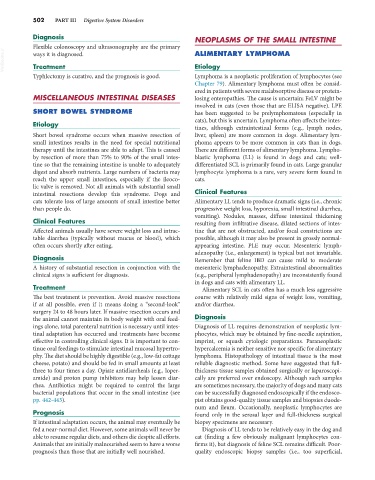Page 530 - Small Animal Internal Medicine, 6th Edition
P. 530
502 PART III Digestive System Disorders
Diagnosis NEOPLASMS OF THE SMALL INTESTINE
Flexible colonoscopy and ultrasonography are the primary
VetBooks.ir ways it is diagnosed. ALIMENTARY LYMPHOMA
Etiology
Treatment
Typhlectomy is curative, and the prognosis is good. Lymphoma is a neoplastic proliferation of lymphocytes (see
Chapter 79). Alimentary lymphoma must often be consid-
ered in patients with severe malabsorptive disease or protein-
MISCELLANEOUS INTESTINAL DISEASES losing enteropathies. The cause is uncertain; FeLV might be
involved in cats (even those that are ELISA negative). LPE
SHORT BOWEL SYNDROME has been suggested to be prelymphomatous (especially in
cats), but this is uncertain. Lymphoma often affects the intes-
Etiology
tines, although extraintestinal forms (e.g., lymph nodes,
Short bowel syndrome occurs when massive resection of liver, spleen) are more common in dogs. Alimentary lym-
small intestines results in the need for special nutritional phoma appears to be more common in cats than in dogs.
therapy until the intestines are able to adapt. This is caused There are different forms of alimentary lymphoma. Lympho-
by resection of more than 75% to 90% of the small intes- blastic lymphoma (LL) is found in dogs and cats; well-
tine so that the remaining intestine is unable to adequately differentiated SCL is primarily found in cats. Large granular
digest and absorb nutrients. Large numbers of bacteria may lymphocyte lymphoma is a rare, very severe form found in
reach the upper small intestines, especially if the ileoco- cats.
lic valve is removed. Not all animals with substantial small
intestinal resections develop this syndrome. Dogs and Clinical Features
cats tolerate loss of large amounts of small intestine better Alimentary LL tends to produce dramatic signs (i.e., chronic
than people do. progressive weight loss, hyporexia, small intestinal diarrhea,
vomiting). Nodules, masses, diffuse intestinal thickening
Clinical Features resulting from infiltrative disease, dilated sections of intes-
Affected animals usually have severe weight loss and intrac- tine that are not obstructed, and/or focal constrictions are
table diarrhea (typically without mucus or blood), which possible, although it may also be present in grossly normal-
often occurs shortly after eating. appearing intestine. PLE may occur. Mesenteric lymph-
adenopathy (i.e., enlargement) is typical but not invariable.
Diagnosis Remember that feline IBD can cause mild to moderate
A history of substantial resection in conjunction with the mesenteric lymphadenopathy. Extraintestinal abnormalities
clinical signs is sufficient for diagnosis. (e.g., peripheral lymphadenopathy) are inconsistently found
in dogs and cats with alimentary LL.
Treatment Alimentary SCL in cats often has a much less aggressive
The best treatment is prevention. Avoid massive resections course with relatively mild signs of weight loss, vomiting,
if at all possible, even if it means doing a “second-look” and/or diarrhea.
surgery 24 to 48 hours later. If massive resection occurs and
the animal cannot maintain its body weight with oral feed- Diagnosis
ings alone, total parenteral nutrition is necessary until intes- Diagnosis of LL requires demonstration of neoplastic lym-
tinal adaptation has occurred and treatments have become phocytes, which may be obtained by fine-needle aspiration,
effective in controlling clinical signs. It is important to con- imprint, or squash cytologic preparations. Paraneoplastic
tinue oral feedings to stimulate intestinal mucosal hypertro- hypercalcemia is neither sensitive nor specific for alimentary
phy. The diet should be highly digestible (e.g., low-fat cottage lymphoma. Histopathology of intestinal tissue is the most
cheese, potato) and should be fed in small amounts at least reliable diagnostic method. Some have suggested that full-
three to four times a day. Opiate antidiarrheals (e.g., loper- thickness tissue samples obtained surgically or laparoscopi-
amide) and proton pump inhibitors may help lessen diar- cally are preferred over endoscopy. Although such samples
rhea. Antibiotics might be required to control the large are sometimes necessary, the majority of dogs and many cats
bacterial populations that occur in the small intestine (see can be successfully diagnosed endoscopically if the endosco-
pp. 442-443). pist obtains good-quality tissue samples and biopsies duode-
num and ileum. Occasionally, neoplastic lymphocytes are
Prognosis found only in the serosal layer and full-thickness surgical
If intestinal adaptation occurs, the animal may eventually be biopsy specimens are necessary.
fed a near-normal diet. However, some animals will never be Diagnosis of LL tends to be relatively easy in the dog and
able to resume regular diets, and others die despite all efforts. cat (finding a few obviously malignant lymphocytes con-
Animals that are initially malnourished seem to have a worse firms it), but diagnosis of feline SCL remains difficult. Poor-
prognosis than those that are initially well nourished. quality endoscopic biopsy samples (i.e., too superficial,

